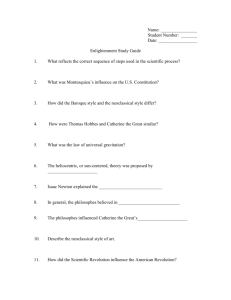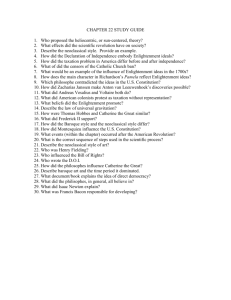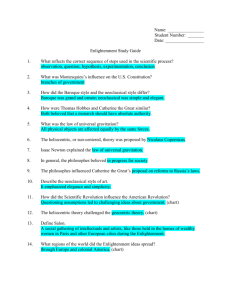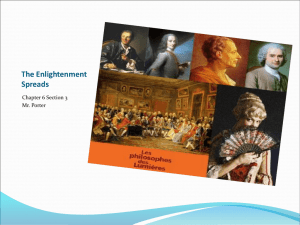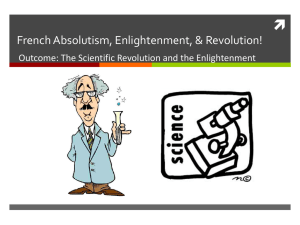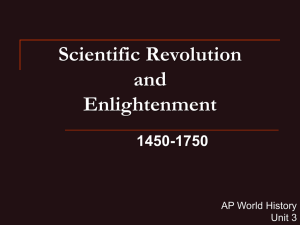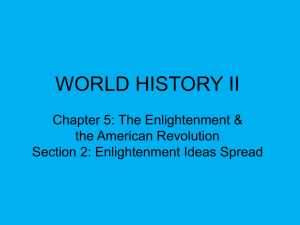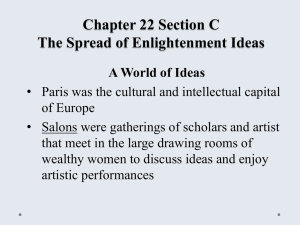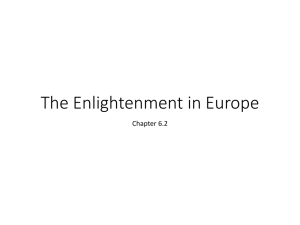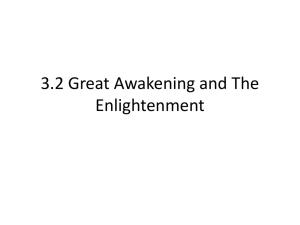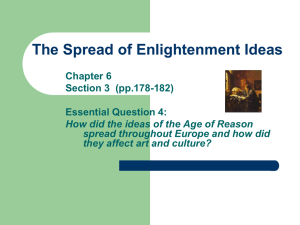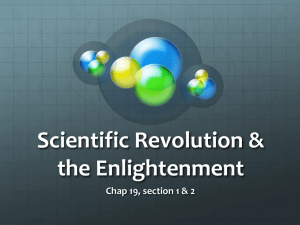Enlightenment and Revolution
advertisement
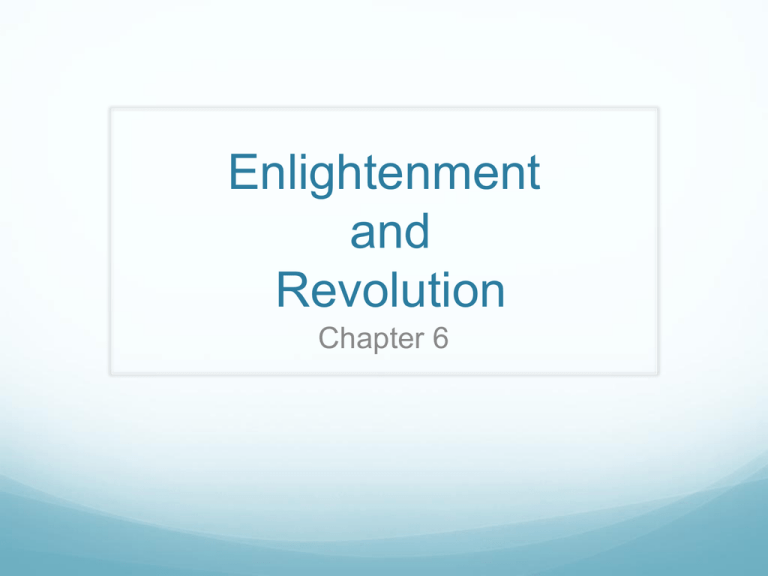
Enlightenment and Revolution Chapter 6 The Scientific Revolution Chapter 6 Section 1 The Roots of Modern Science Before the scientific revolution scholars turn to ancient ____________ or _____________ authors or the Bible for answers to scientific questions The Medieval View Geocentric Theory meant that the _________ revolved around the _________ An idea supported by Ptolemy and the Bible A New Way of Thinking The basic idea of the scientific revolution is what? Based on observation and questioning How did the Age of Exploration affect the way people thought? And the printing press? The “classical world” had come to an end A Revolutionary Model of the Universe The Heliocentric Theory Nicolaus Copernicus was the first to reason that the earth and stars moved around the sun; an idea also known as the _________________ theory Why didn’t Copernicus want to publish his works? Galileo’s Discoveries Galileo’s 1st telescope, 1609 Galileo’s findings refute Aristotle’s ideas but support which scientist? Conflict with the Church Why would the church warn Galileo about supporting Copernicus and his theories? What happened to Galileo? The Scientific Method The scientific method is a logical procedure for _______________ and ________________ ideas Problem, hypothesis, experiment, conclusion Bacon and Descartes Bacon urges scientists to experiment and draw conclusions Descartes relies on mathematics and logic…doubted until proved (“I think, therefore I am”) Newton Explains the Law of Gravity Heaven and earth are linked through gravitation…every object in the universe attracts every other object The Mathematical Principles of Natural Philosophy explained what? The Scientific Revolution Spreads Scientific Instruments Zacharias Janssen invents the first what? Van Leeuwenhoek uses Janssen’s invention to do what? Torricelli and the barometer, Fahrenheit and Celsius both created _________________, the difference? Medicine and the Human Body On the Structure of the Human Body, significance? Introduction of the vaccine, giving small amounts of the germs helps with that? Discoveries in Chemistry Boyle’s Law of gases What is the significance of all of this? 6.1 Daily Questions 1. Explain the differences between the geocentric and heliocentric theories. What did the church think about the heliocentric theory, why? 2. Explain the differences between Bacon and Descartes approaches to the scientific method. Honors Only 3. How does the Scientific Revolution support the saying “necessity is the mother of invention”? The Enlightenment in Europe Chapter 6 Section 2 Two Views on Government Enlightenment-an intellectual movement that stressed reason and thought but what else? Hobbe’s Social Contract Civil War convinces Hobbes of the cruel nature of people The idea of a social contract that asks people to hand over rights in exchange for _________ and ______. What gov’t did Hobbes believe was best? Locke’s Natural Rights Believed in people and the idea of selfgov’t Life, liberty, and property Power comes from the consent of the people The Philosophes Advocate Reason Philosophes-social critics in France that applied reason to all aspects of life Reason Nature Happiness Progress Liberty Voltaire Combats Intolerance The most brilliant and influential philosophe was a satirist, meaning what? Who did he attack? Fought for tolerance, reason, and freedom of ______ and _______. “…defend to the death your right to say it.” The Philosophes Advocate Reason Montesquieu and the Separation of Powers The study of political __________, believed what country was the bestgoverned? Executive, judicial, and legislative powers contributed to a balance of power Separation of powers=_______ and ___________ Rousseau: Champion of Freedom “Man is born free, but everywhere he is in chains.” Belief in ________ democracy How was Rousseau’s social contract different from Hobbes’? The Philosophes Advocate Reason Beccaria Promotes Criminal Justice Laws exist to preserve justice not to do what? Speedy trial Torture should never be used Capital punishment should be abolished, punishment based on the crime “Greatest good for the greatest number of people” Women and the Enlightenment Most of the reforms and ideas of the Enlightenment did not address women Mary Wolstonecraft A Vindication on the Rights of Woman 1792…women’s education is just as important AND useful Enlightenment ideas were spread in social gatherings called salons Why might men hesitate to give women education and equality under the law? Legacy of the Enlightenment The Enlightenment produced 3 long-term effects: Belief in Progress Strengthening of science’ philosophers and reformers attempted to change many long held beliefs such as? A More Secular Look People began to question _____________ beliefs Started answering religious questions with math and science instead of the Bible Importance of the Individual Encouraging people to use their own abilities instead of relying on what? Turning point in history? 6.2 Daily Questions 1. Explain the difference between Hobbes’ and Rousseau’s social contract. 2. Explain the impact of Montesquieu’s ideas on American government. Honors Only 3. In your opinion, who was the most influential Enlightenment thinker? Why? The Enlightenment Spreads Chapter 6 Section 3 A World of Ideas Enlightenment ideas spread from Paris and the thinkers that lived there…salons hosted what groups of people and their ideas? Diderot’s Encyclopedia 1751, Geoffrin finances the writing of an _____________ that includes articles by the leading scholars of Europe The publishing of the Encyclopedia angers who? Why? Salons and the Encyclopedia helped with the spread of ideas along with what? Enlightenment ideas even spread to the _________ ________...significance? New Artistic Styles Neoclassical Style Emerges Baroque art deals with grand and ornate designs, example? Neoclassical designs were simple yet elegant, like that of Greece and Rome Changes in Music and Literature Classical music emerges…differences? Novels became popular among all classes…entertaining stories in everyday language Pamela and Tom Jones, examples of ____________ novels Baroque or Neoclassical Baroque or Neoclassical? Baroque or Neoclassical Enlightenment and Monarchy The enlightened despots started a new trend of respecting the peoples’ rights…an idea encouraged by ____________ What motivated the enlightened despots? Frederick the Great (Prussia) Reforms Religion Censorship Education Justice system (torture) What about the social order? “The first servant of the state.” Enlightenment and Monarchy Joseph II (Austria) Son and successor of Maria Theresa Legal reforms and freedom of the ______ and _______ What was Joseph’s most radical reform? Reaction? Overall result? Catherine the Great (Russia) Absolute monarch that sought reforms (wrote to who?) Creates a commission to change laws…did it work? Why did Catherine’s views on serfdom change? Enlightenment and Monarchy Catherine Expands Russia Gains territory in southern Russia near the Mediterranean Poland is split up by ______, _______, and _______ into partitions Overall Catherine expanded territory and international control for Russia 6.3 Daily Questions 1. How does Neoclassicism reflect the ideas of order and reason? 2. Explain the differences between absolute rulers and enlightened despots. Honors Only 3. Why do you think Enlightenment ideas spread so rapidly?
